In late 2022, Duolingo completely overhauled how their app works. I had used Duolingo previously, but when I heard this update was so massive that it had upset a huge portion of the user base, I knew I had to retry it. So that’s what I did. I signed back up for Duolingo and used it for three months. Here’s what I found, and what I now think about this Spanish language learning app.
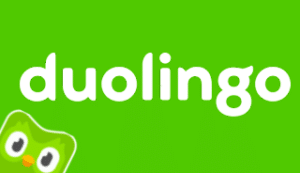
Duolingo
- Free Version
- Mobile App or Desktop
Pros
- Lessons take just 5 minutes
- The program is legitimately fun (and somewhat addicting)
- The vocab repetition is great for burning new words into your brain
Cons
- There is very little conversational practice
- Not much emphasis on grammar
- Lessons feel cursory compared to those from other apps
Duolingo Spanish Updates: How It Now Works
The biggest change with Duolingo has been the switch from the tree format to the path. In short, Duolingo used to have a pretty flexible learning format where you could pick and choose what you wanted to learn.
You could do basic exercises like matching vocab words, listen to short stories, learn how to order food, or talk about sports. Or, you could always jump to old lessons to review, or work on legendary status. In other words, you could essentially drive how and what you wanted to learn.
The update, however, has turned the tree into a linear path. Rather than having optionality, you work on a straight line through lessons. The lessons are organized into units on the path, and there are hundreds of units to complete to finish the entire language course.
Basically, the units are kind of like checkpoints under the old version of Duolingo Spanish. The crown system is also gone, and it has been replaced by the path as well.
So rather than earning different crown levels within a particular skill on the tree, they’ve taken the same lessons and spread them out across the path.
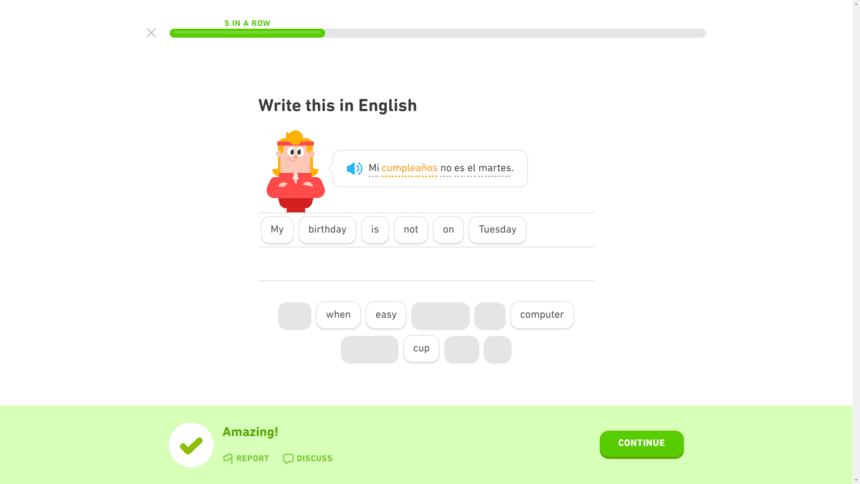
Plus, another change is that they’ve taken stories, which used to be separate on the dashboard, and integrated them directly into the learning path. The stories, which are really fun and popular, are no longer separately accessible under a different tab.
To be clear, you can actually review old stories you’ve already completed on the path under the “practice” tab, but it’s not like before, where you could go do a new story whenever you wanted.
Also, “tips” are now gone from the program, and replaced by a grammar guidebook at the start of each unit. That’s actually a good opportunity to explain how Duolingo does grammar instruction.
Rather than build grammar directly into their lesson work (similar to how Babbel Spanish and Pimsleur Spanish do it), Duolingo Spanish used to provide grammar “tips” with each skill on the tree. Now, however, they’ve dialed the grammar back and put it into the form of a “guidebook” at the start of each unit on your path.
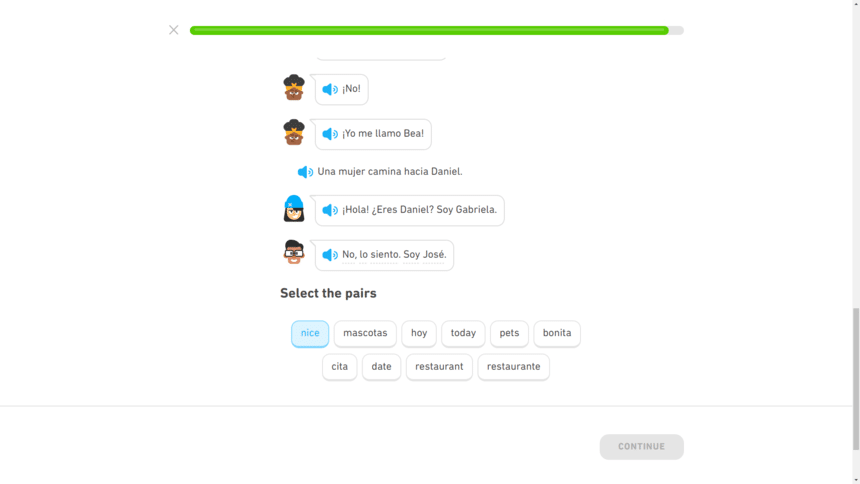
Lastly, in a similar vein, Duolingo has taken their practice work and layered it into the path as well, based on a spaced repetition model. This is opposed to letting people practice of their own volition, as it used to be.
To recap these major updates: the path has replaced the learning tree; stories are now layered into the path; the grammar tips are now guidebooks at the start of each unit; and practice is also worked into the path like the stories.
Otherwise, the content of each lesson remains the same. The exercises and drills that make up the heart of Duolingo remain relatively unchanged. You’ve still got basic matching pairs, translation exercises, speaking drills, and writing exercises.
It’s really the same core exercises each day, with the same funny little characters and motion graphics.
Duolingo Spanish Negatives (What I Don’t Like)
Now that I’ve broken down the new updated format of Duolingo Spanish, let’s get into what I like and don’t like about this update. And let’s start with the negatives, as there seems to be a lot more criticism of these changes then there is praise for it.
Lesson Navigation Is Now Harder
The biggest downfall of this update in my eyes is how difficult it has become to navigate through the course. If you want to go forward or backward, you have to scroll through for an eternity.
Basically, you have to follow the new path all the way down, or all the way back up. The old Duolingo was not like this. The old user interface had easy to read lesson names and icons, so you could tell exactly what each skill or level was about.
The issue with this has to do with going back to review. Previously, it was really easy to go back to older lessons to get more crowns and work on legendary status.
Now, however, you have to scroll a long way, and you’re just guessing at what each step in the path covers as they are not individually labeled.
For example, say you’re at unit 60; however, your legendary status only goes to unit 30. This means you would need to scroll 30 units up to find your legendary progress.
And even then you won’t have a great idea of what you’re reviewing because the steps aren’t labeled. This can be a big deal.
Let me explain further. Let’s say you’re getting ready for a trip to Mexico City and you want to review the lessons on ordering in a restaurant and asking for directions.
These particular lessons are now much harder to find for those specific reviews. The bottom line is that it’s not a huge substantive issue, but it is definitely annoying.
Frankly, I feel like a really easy fix for Duolingo would be to collapse the path view for all but the current unit. In other words, just allow users to scroll through unit headers with labels of what’s within, in order to find what you’re looking for. That would be nice improvement.
Light on Grammar
The second complaint I have with the update has to do with grammar. Duolingo has really scaled back their grammar instruction by doing away with “tips.”
The new grammar guidebooks that are appended to be beginning of each section are helpful and contain some of the same material from the old “tips” sections, but honestly, they feel somewhat neutered.
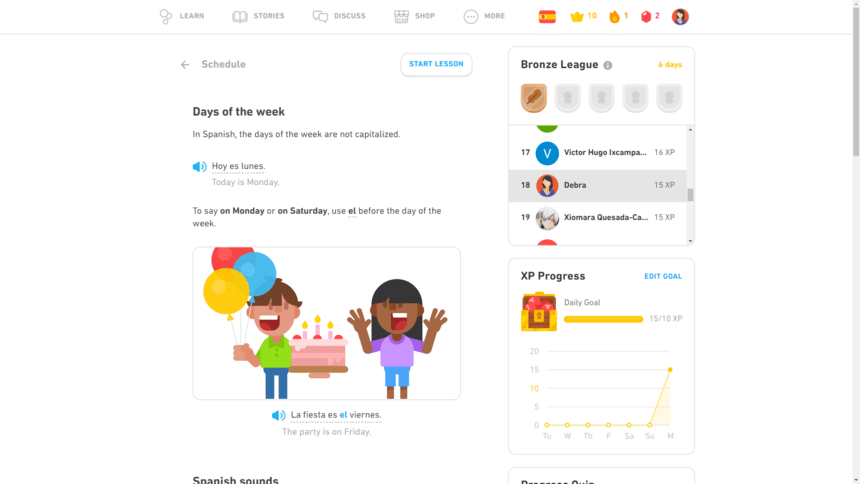
It feels like these more robust grammar tips have been replaced with a few example phrases and teaching points. It’s not a great way of managing grammar instruction in my opinion.
Too Easy
Something else I have noticed in using Duolingo Spanish for a second time is that the program overall feels a bit easier.
Now, it could just be me, but it feels like post-update, the program is much heavier on repetition. Every stepping stone on the path just hammers the same phrases and concepts, over and over.
I might just be more acute to differences post-update, or maybe it’s just the new linear format, but I’ve seen other Duolingo users say this as well. The program overall just feels a little bit more repetitive and easier.
Too Many Ads In The Free Version
Full disclosure, my fourth negative is something I actually haven’t experienced myself since I pay for Super Duolingo, their ad-free premium version. However, I’ve heard from a lot of people on the free plan that the ads are much heavier and more frequent after the update.
To be honest, this doesn’t really shock me. If we peel back the layers, one of the biggest points of the update for Duolingo was to get more people to upgrade to the paid Super Duolingo.
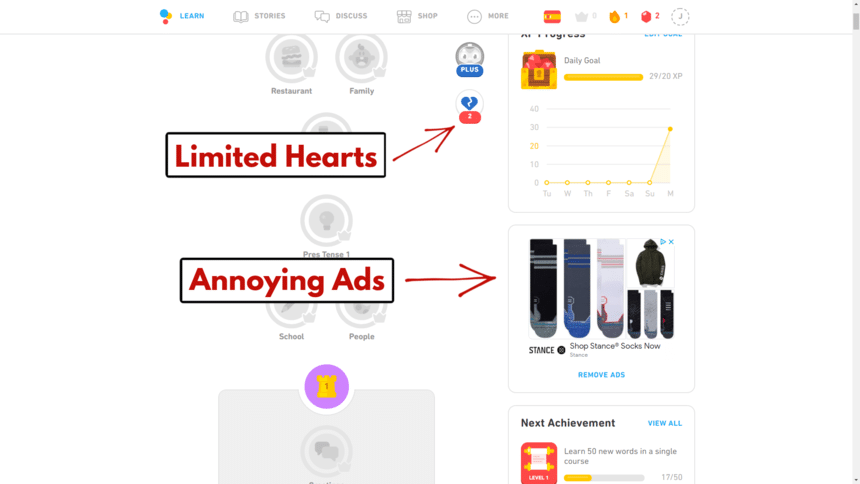
They say this major change was for improved learning science and user experience, but if we’re being honest with ourselves, part of it was driven by the desire to get more people to upgrade from free to paid.
The free version under the new format is harder to navigate than if you have the paid version, and with the heavier ad impressions, I just think they’re really trying to get people to pay up for the Super version.
Duolingo Spanish Positives (What I Like)
Now let’s switch gears and discuss the things I actually do like about Duolingo Spanish.
Path Offers Learning Structure
Even though everyone loved the old tree and skills framework, the reality is that it wasn’t perfect either. Because you could jump around to learn whatever you want, it gave the program a very hodge podge feel.
In fact, that’s why Duolingo had suggested ways of using the program, such as the waterfall method (which by the way, not that many people used). The reality is that there are lot of people with 1,000+ day streaks who still have low confidence in their ability to speak Spanish.
They just don’t feel comfortable jumping in and holding conversations. And the reason for this, at least in part, was the lack of structure. People used the learning modules willy nilly, and there was no flow to the program.
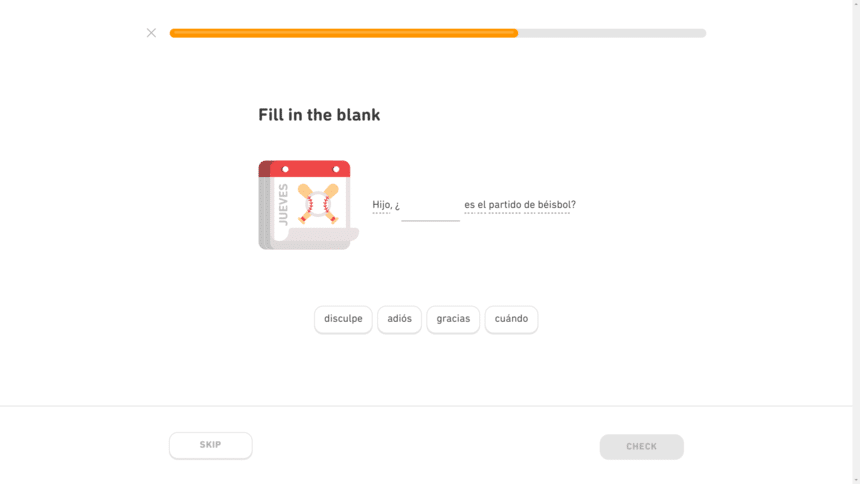
That is why with this new path structure they’ve placed a big focus on progressive building. The lessons all build on one another, and even the stories have consistent characters which get developed along the way.
This update brings the Duolingo courses in line with other Spanish language learning apps that are more structured and help people to work through language programs in an orderly fashion.
Spaced Practice & Review
Another aspect of this Duolingo Spanish update that I actually like is how they’ve built practice sessions right into the path. Every few stepping stones, you’ll get a review session that forces you to practice stuff you’ve already learned.
This is a change from the past program, where it was on you to manage your own reviews and practice work.
This built-in practice work ensures you’re regularly revisiting material, which is crucial for learning Spanish.
Spaced repetition is a huge factor in internalizing a new language, and I think this new format will ultimately help learners develop a stronger foundation long term as they stick with it.
Shockingly Fun
Lastly, my final positive is that the app is still fun. Yes, it’s more rigid, and there are definitely some negatives with the changes they’ve made, but the content is still the same.
The lessons only take 5 minutes; you still get to compete against other users in leagues; you can still do friend quests; you can earn gems, lingots and XP points; and all the same little characters and motion graphics are still there.
In other words, the gamification aspect of language learning with Duolingo that everyone loves is still there front and center, and I really like that.
Final Verdict: Is Duolingo Good For Learning Spanish?
That brings me to my closing thoughts—is Duolingo worth it? Or is it time to consider another app? Honestly, my thoughts on Duolingo haven’t really changed that much post-update. Even before the major changes, I thought Duolingo was best used as a supplemental tool, and not a standalone Spanish program.
There is good reason why people with 1,000 day streaks still complain about not feeling comfortable and confident is their conversational abilities. It’s because Duolingo is a brain game—not a full blown Spanish course. Thus, I would say that if you’re just looking to learn some basic phrases and elementary-level understanding of Spanish before a trip, then Duolingo is great for that. Go for it.
However, if you’re serious about becoming fluent in Spanish at an intermediate to advanced level, you have to use another Spanish app which is more robust, like Babbel, Pimsleur or Rocket Spanish, and then supplement with Duolingo Spanish. That’s where I see Duolingo being the most beneficial—as a complementary tool to a more comprehensive language course.
After using Duolingo for three months, I definitely think there are better apps to learn Spanish. While Duolingo is fun and kind of addicting, it just isn’t that effective for actually learning to listen and speak.
The problem with Duolingo Spanish is that it can take a really long time to learn Spanish. If you do just one lesson per day, you really won’t make much progress. You’ll get a long streak, but you won’t become fluent.
I like Duolingo for what it is, a fun game. I love doing the lessons and keeping my streak up, but feel as if it would take forever to actually become fluent in Spanish just using the Duolingo app.




